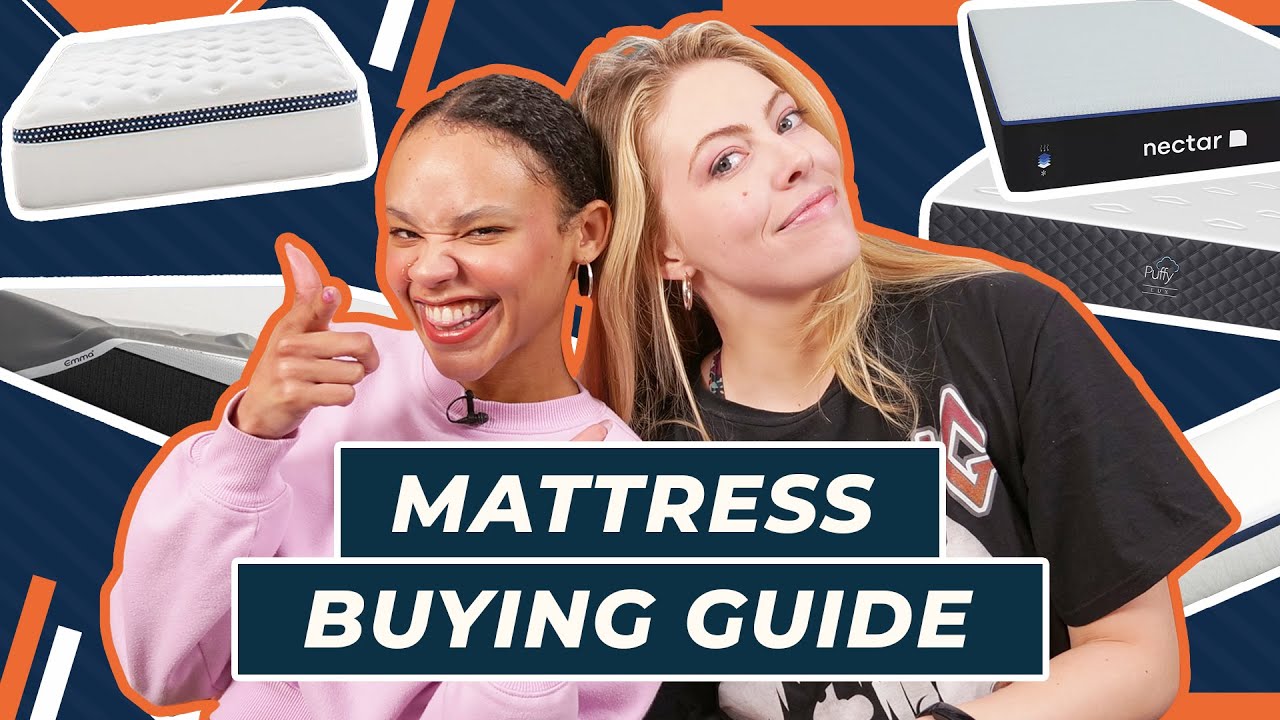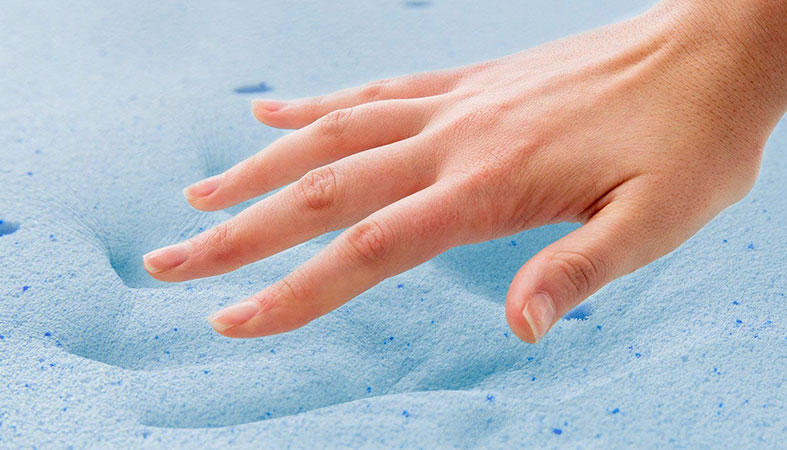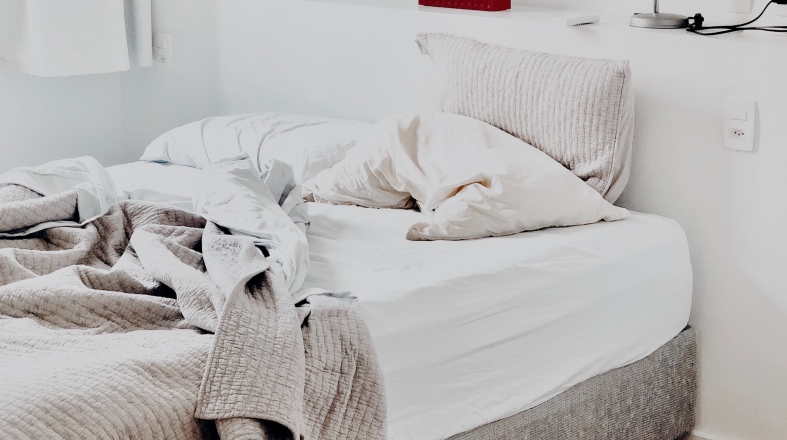Buying a mattress that’s right for your body and sleep needs is one of the biggest investments you can make for your physical and mental health. There’s a lot of noise out there both in stores and online about what’s “the best” bed.
Truth is, there is no “best” that will work perfectly for everyone. Which mattress is perfect for you will be different than what works for the person standing next to you. This buying guide for mattresses should improve your understanding of what a bed does and how your body may affect your choice, so hopefully, we can get you on the road to finding your optimal sleep.
Watch Our Mattress Buying Guide Video

Mattress Shopping Guide
In this section, we will outline several key features your mattress should or could offer that you may want to consider when making your purchase. Which you prefer will depend largely on your body size, shape and position preference, and we’ll explain each so you know what you’re looking for when you go shopping.
Read More: How to Choose a Mattress
Longevity: Considerations for Long-term
A good mattress can last you years if you choose correctly based on your long-term plans and life trajectory. Though budget or space constraints may factor into your choice, brands that can “live” with you will maximize your investment.
Size
Your choice of sides will depend on several factors, including how much space you have, your body size, growth expectations, and if you need to share it. Let’s discuss each standard mattress size one at a time, but note that some companies may not offer every size. Height will also vary depending on which brand you choose.
- Twin (38” x 75”) – This is the size most often chosen for children who’ve outgrown the crib as it offers plenty of room for their body to grow into an adult. Adults with space limitations should also be adequately served by this size.
- Twin XL (38” x 80”) – This size bed is very commonly found in college dorm rooms as it conserves space but also is slightly longer to accommodate taller individuals. This size is often only slightly more expensive than the regular Twin and may be worth the investment for individuals who need more room to stretch their legs.
- Full (54” x 75”) – Though there are couples who happily share a twin size, we typically recommend most folks not go any smaller than a Full size bed. This is a great choice for singles who need more room to spread out or couples who do not have bedroom space to accommodate a larger size.
- Queen (60” x 80”) – This size tends to be the most popular model of any bed sold to singles or couples. It offers plenty of space to stretch out and will usually fit into most bedrooms without issue.
- King (76” x 80”) – If you have a large bedroom and/or need to share your bed with a partner, kids, or pets, you may want to invest in this size. This is the largest of most brands and offers a luxurious amount of room.
- California King (72” x 84”) – This bed is slightly narrower than the regular King and offers an extra four inches in length to accommodate those with exceptional height. Even if you aren’t on the taller end of the spectrum, this size may be better suited to your bedroom shape.
Thickness
Mattress height varies depending on which brand you choose, and more entry-level choices tend to be much thinner and simpler in their design that taller luxury matress brands that have more complicated comfort layers and support systems. If you have trouble getting in and out of bed, a mattress that is exceptionally tall may prove to be a problem.
Durability
Beware that price is not always an indication of quality, and some materials will naturally wear out faster than others, depending on how they are formulated and placed. In general, latex tends to last longer than poly foams, and tufting tends to endure natural wear and tear longer than adhesives. The longevity of coils will depend on their gauge and how they are attached to one another.
Adaptability
Choosing a mattress with a universal feel that can adapt to changing bodies or differing preferences is not only ideal for couples, it is also preferable for folks looking to prolong the usefulness of their mattress. If a bed can accommodate your changing size or sleep positions, this may enhance its long-term value.

Comfort and Support: What’s the Best Ratio?
Every body requires a different recipe of comfort and support, and the amount you require depends on how many curves you have, where they are, and how much you weigh. Though our reviews tend to address feel based on average sized people, each item in this category may be experienced differently by differently shaped individuals.
Firmness
All mattresses should contain a blend of comfort or softness and support (which tends to be more firm.) Beds with enhanced support systems may feel firmer than beds with enhanced comfort. Folks who are considerably heavier will often experience a brand as softer than sleepers who are much lighter because of the ability of their body to press through layers.
Need more details? Check out our complete mattress firmness guide.
Pressure Relief
Often referred to as “comfort,” pressure relief is typically delivered by softer materials at the top of the mattress that conform to your curves. When your bed molds to the line of your body, excess pressure is less likely to build up, which can cause discomfort and restless sleeping. Those who are extra curvy or who have sore joints often prefer mattresses that have enhanced comfort systems.
Sinkage
The materials that make up your comfort system and your body weight will determine how deeply you sink into your mattress. A bed with a deeper hug will often offer more pressure relief than one with a gentle cradle, and this feature is highly preference based. If you prefer to feel like you’re floating on top of your mattress, you will prefer beds with less sinkage.
Spine Alignment
If your body sinks more in some areas than in others, you may not be experiencing optimal spine alignment. When you lie down on your bed, you should feel that your spine is in a neutral position, or the position it’s in when you’re standing up straight. If it feels curved or awkwardly bowed, you run the risk of experiencing discomfort when you wake up. Many brands include zoning to help optimize sleep posture.
Sleep Positions: Different Needs For Different Positions
Now that we’ve established the key features of a mattress, let’s discuss what factors are critical to consider depending on what position your body gravitates to during the night. Remember the amount of firmness to comfortably accommodate you will be affected by your body weight.
Back Sleepers
For back sleepers, firmness requirements are more subjective and a matter of taste rather than necessity. You want to look for a bed that supports the curve of your lumbar spine so that pressure doesn’t build up in your hips or upper back when you’re sleeping and your spine remains comfortably aligned.
Side Sleepers
Pressure relief tends to be more crucial for side sleepers because you are resting with the entirety of your weight pressing on a narrower surface of your body than if you’re laying on your back or stomach. The line of your body tends to be curvier in this position, as well, so some additional softness may help ensure that no pressure builds up under hips or shoulders.
Stomach Sleepers
If you’re like most individuals, you carry the bulk of your weight in your hips and they may sink deeper than the rest of your body in this position, causing you to lose optimal spine alignment. A firmer mattress with enhanced support or zoning through the middle of the mattress can often help counteract this for stomach (belly) sleepers.
Maneuverability
A majority of sleepers do not commit to one position exclusively and often move between one, two or three throughout the night, and they are called “combination sleepers.” If this is you, sinkage can affect your ability to move effortlessly between positions. Also, materials that are slower to respond (i.e. traditional memory foams) may be trickier to navigate.

The Things That Bother Us: What Disturbs Your Sleep?
The following mattress features may not be deal breakers for you and aren’t as crucial for comfort as those listed above, but tiny annoyances can keep you awake and many brands go to lengths to alleviate these concerns.
Excessive Heat or Cold
The amount of sinkage or the composition of the mattress will affect on how warm or cool it gets through the night. You’ll want to look at what’s in that mattress.
Ultra-dense memory foam that is more traditional often sleeps exceptionally warm, while innerspring beds allow for the most air to travel through and are typically the coolest brands. New technologies like phase-change materials and gels may revamp traditional feels.
Noise
Some bedding materials are notorious for making a lot of noise when you move around at night, which can cause disruptions to your sleeping, especially if you’re exceptionally sensitive to sound. Innersprings that are not in individual pockets and are interconnected to one another can often rub together so that you hear them squeak.
Allergens
Whether the materials or themselves or the allergens and odors that they may encourage, if you suffer from allergies, you want to make sure that your bed isn’t keeping you awake with sneezing and sinus pressure. Many brands offer anti-microbial features or hypo-allergenic materials to help sufferers sleep easier.
Weight or Mobility
Though a relatively minor concern, an excessively heavy mattress may be harder to place within your room or move your bed alone. Heavy mattresses may also cause difficulty in lifting corners to put sheets on the bed.
Many brands will list the weight of their mattresses on their websites, so be sure to take that into account and perhaps invest in delivery service to help you move the bed into your room.
Shareability: Keys to Peaceful Partnered Sleep
Edge Support
Sleeping alone or partnered, a mattress that has reinforced edges will increase the amount of space you can comfortably stretch out in while still remaining well supported. Because of the nature of their compressible materials, bed-in-a-box options might perform less optimally in this category. If you are someone who needs the maximum amount of space in a smaller bed or regularly sits on the edges, you may want to think about this feature.
Read More: What is Mattress Edge Support?
Motion Transfer
Beds that cannot absorb movements can cause disruptions throughout the night for sleeping partners, especially if you’re up and down or tend to change positions a lot. Foams, especially memory foams, tend to perform exceptionally in this category, while traditional innerspring might transfer more motion. Light sleepers who share their bed may consider an all-foam brand to ensure peaceful sleep.
Sexual Considerations
If you and your partner enjoy an active sex life (see bed picks here), you want to make sure your bed enhances your experience rather than put a damper on the fun. Less responsive materials may make it more difficult for you to change positions or move around on the surface of your bed, while beds with a touch more bounce may offer the push-back you need to navigate easily.
Customization
Around 80 percent of couples have different body shapes and sleep preferences, which can make compromising on a mattress a little trickier than shoppers who sleep solo. Many brands have discovered ways to accommodate these issues, however, by offering customizations and split comfort levels so that you and your partner can both enjoy the exact firmness you require to sleep comfortably.

How much should you spend on your mattress?
While it’s very important not to exceed your budget and put stress on your finances by buying a bed, you do need to consider a mattress as a significant investment in your physical and mental health. Expensive does not always mean better, so you may look for brands who endeavor to keep costs low by cutting costs in the supply chain or by selling exclusively online.
Interested in reading more? View our guide for best budget mattresses here.
What Type of Mattress Should I Buy?
Despite what the internet and mattress salesmen may want you to believe, there is no any one material that is superior to another. Each person has their own list of preferences, which hopefully you have established by reading this guidance.
Got your shopping list handy? Awesome! Let’s look at what features and selling points each material delivers, as well as the many different types of beds you can choose from.
Innerspring
An innerspring mattress may be the most commonplace and it’s likely that you’ve slept on this type of bed at least once in your life. In recent years, there’s been a lot of development of what we consider a traditional coil system, and it’s good to know the advantages and disadvantages of the different features you might encounter.
- What are different coil configurations?
Configuration of your coils may affect how motion transfers, the bed’s ability to contour to your shape and its overall long-term durability.
Bonnell coils are very common in mid-level beds and are shaped like hourglasses. In slightly higher-end beds, offset coils offer slightly better pivot and contouring ability with a hinged, squared off top and bottom. Both Bonnell and off-set offer a more classic experience.
Newer beds may include what’s called continuous wire, which uses one wire to build the entire system, which may offer slightly more stability than traditional systems. Conversely, individually wrapped coils are a modernization that can offer enhanced body contouring and motion isolation..
- What is coil gauge?
Mattress gauges range from around 12 to 16. The higher the number, the more flexible the coil will be, contributing to a “softer” feel overall. Thicker wires have been shown to feel much firmer and may offer enhanced durability over the long-term.
- What does coil count mean?
Many brands provide their coil count as a sign of the bed’s quality, and beds with higher coil counts may provide enhanced support and durability. However, more is not always more, and beds with a coil count above the minimum standard of about 400 for a Queen do not demonstrate significant advantage in longevity.
- Is coil-on-coil better?
Using more than one type of coil system can harness the advantages of multiple styles by offering body conformance in a top layer of coils and enhancing the bed’s support system by using a sturdier construction down below.

All-Foam
All-foam beds are a more modern development and can feel quite different to sleepers who’ve been resting on springs for most of their lives. There are many different kinds of foams of various densities and firmnesses which can change up the experience, and there are several terms you might encounter.
These beds are typically built with polyurethane foams, formulated using petro-chemicals or sometimes more bio-based oils. Densely formulated or visco-elastic foams, often called memory foams, are a type of poly foam. Latex, either all-natural or synthetic blend, may also be included in an all-foam construction.
- Is responsiveness important?
All materials respond to pressure differently, but responsiveness is often discussed with foams, especially at the surface of a bed. Mattress foams with a slower response may be difficult to move around in, while quick-responding materials are springy to the touch and may even have some bounce (though usually not as much as a spring might).
- What is closed vs. open cell?
Closed-cell poly foams are typically much more dense and resistant to airflow, making them superior at insulating temperature and providing structural support. Open-cells feel softer because air travels through quickly when pressure is applied to them, and their increased airflow also helps keep these materials from overheating.
- How does Indentation Load Deflection (ILD) factor?
Some foams are discussed in terms of how many pounds of pressure are required to compress the foam by 4 inches. The more pressure required (or higher ILD) the firmer the foam typically is.
- What do densities mean?
The density of foam can be deceiving as different densities have different implications for different kinds of foam. For standard polyfoam, denser foams are often firmer and usually make up the base or support of an all-foam bed. Typical all-foam bed bases have a density of about 1.8.
- Why is all-foam great at motion isolation?
Foams are used in multiple industries to keep vibration muffled because of their ability to absorb energy at the source and preventing it from moving across the surface. This is great news for light sleepers.
Memory Foam
Though memory foam beds are a kind of all-foam construction, they deserve their own category because of their unique properties and advantages. There are several misconceptions surrounding memory foam that you should be aware of when shopping for a new bed.
Check Out Our Comparison: Foam and Memory Foam Beds
Memory foam beds were all the rage in the 1970s and 80s when the material was first developed by NASA to cushion astronauts in space. Traditionally, memory foam reacts to heat and pressure to slowly conform around the object (or person!) resting on it.
It gets its name from the fact that it often leaves an impression of that object, even after pressure is removed. Classic memory foam offers tight body conformance, super slow response, and often retains heat.
- What does density mean in memory foam?
For memory foam, density refers to how much one square foot of the material weighs. Extremely dense memory foam (5 and above) is slowest to respond and can often make you feel like you’re crawling around in quicksand. These foams are often found (in varying amounts) in high-quality memory beds and provide a classic and more durable experience.
Lower density memory materials (2-4) are much more responsive to pressure and allow air to flow easier so they are less likely to retain heat, so they are much cooler and easier to move around on. These foams may, however, have a tendency to break down quicker over time compared to higher densities.
- Why does some memory foam have gel?
To offset some of the heat retention concerns of classic memory foam, many brands have incorporated gels into their formulations to compensate for temperature concerns of minimal airflow. This gel helps to redirect heat away from the body and keep it from building up against where you’re resting.
- Is memory foam full of chemicals?
In the early days of this type of material, there were concerns about its flammability and chemicals contained in its construction. Modern memory beds often come with certifications that guarantee consumer-safe levels of potentially harmful materials and emissions. Better quality beds often have more than one certification, and all foam beds are required by law to incorporate flame retardants.
Read More: Toxic Materials in Memory Foam Beds

Latex
Latex mattresses are usually (but not always) made from the milky white sap of the Hevea Brasiliensis tree, most of which is sourced in Asia. Its popularity in higher-end bedding materials and mattresses owes to its more natural formulation, its great pressure relief, and its temperature regulation.
Latex brands tend to be slightly more expensive than their all-foam or innerspring competitors, but the feel and experience of these brands may be highly different depending on processes used to build the latex and materials used to complement them in the mattress.
- Is all Latex natural?
No. Some latex is completely synthetic and is formulated using petrochemicals that mimic the experience of natural latex. Some brands blend synthetic with natural to provide a more cost-effective latex product.
- How does Talalay compare to Dunlop processing?
Though Talalay and Dunlop both originate from the same sap, the methods used to turn that sap into foam result in vastly different feels.
Dunlop latex is poured into a mold, vulcanized in an oven and then thoroughly washed. The process and finished product tends to require fewer chemicals and feel more substantial and dense. Some argue that this process is “purer” than other methods.
Talalay, by comparison, requires a somewhat more intensive process that may involve a few chemicals, which is why Talalay is never certified organic. The resulting foam, however, is lighter, more consistent and springy compared to latex prepared using the Dunlop method.
- How is latex different from memory foam?
There are many brands that emphasize the different feels and advantages of latex over memory foam beds, but it really comes down to what you prefer. Latex offers great pressure relief, but you won’t get the tight, body-conforming hug you experience with memory materials. In addition, latex responds quickly to pressure so it eases repositioning, and the substance is naturally heat resistant.
- What if I’m allergic to latex?
Whether or not you should consider a latex bed if you are allergic is a discussion best conducted with your doctor, as only he or she can truly evaluate risk of allergic reaction. Those with minor allergies may not be affected if they never touch the latex directly, but those with more severe allergies may want to steer clear.
- Does latex last longer?
Yes, it does tend to last longer, especially more natural or organic brands, and this is often reflected in their longer warranties. Though they last longer in general, you should still usually replace a latex bed after 8-9 years.
Organic
A majority of beds that use organic labeling use a mix of latex, cotton, and wool to build their constructions. Cotton is typically used for the covers, while latex builds the comfort and support layers encased by wool to wick away moisture and provide a natural flame retardant that doesn’t require additional chemicals. Some companies have gotten even more creative by using flax seed and coconut husks in their constructions.
Those who are environmentally conscious or prefer more eco-friendly materials have a lot to choose from on the market today, though they should be aware that many brands out there make claims that are not substantiated by third-party certifications.
Very few brands are 100% organic, but many come as close as they possibly can with as many certified materials as they can fit into their constructions. Look for tags that indicate evaluation by GOLS (Global Organic Latex Standard) or another organization called GOTS (Global Organic textile Standard) that signify that the product meets standards required for organic labeling in Europe and the USA.
See Our Guide: Top Rated Organic Beds
- What’s the difference between all-natural and organic?
All-natural products are sourced using more natural materials but may often contain some percentage of synthetic material or are processed using non-organic chemical processes. If a product is certified organic, it means it has met rigorous standards set by global organizations.

Hybrid
A hybrid mattress uses a blend of two different materials to combine the advantages of each and offset any disadvantages the materials might have on their own. A hybrid is a “best of both worlds” experience, and these mattress often score really high among consumers for their attention to detail and diverse mix of features.
A hybrid may be a blend of two different foams (i.e. memory and latex) or a blend of foam with a brand new kind of material (elastic polymers and foam). Most commonly, bed companies produce a mix of foam and coils to provide the bounce and airflow associated with innerspring mattresses while delivering on the pressure relieving qualities associated with foams.
A hybrid may require a slightly larger investment than competitors that are built with only one type of bedding material, but they often provide substantial benefits that add considerably to their value. More modern hybrids are outfitted with fantastic new technology that can alleviate even the biggest concerns associated with traditional materials.
Worried about memory foam sleeping too hot? By pairing memory foam with a coil base, air flow beneath the coils can help heat disperse so sleep cool and pressure free all night long.
Airbed
When people hear “airbed,” their first thought is those cheap guest beds you store in a closet and blow up with a bicycle pump when your guests arrive and deflate as soon as they leave, but this is only one segment of a vast market harnessing the power of air to provide a highly customized sleep.
Newer air mattresses often contain a comfort layer that can provide foam pressure relief to the experience of an airbed, and some air beds are as tall as their traditional counterparts. While many airbeds on the market are designed for only occasional use (such as when guests arrive), but other choices are taking their place in the master bedrooms of many sleepers.
Let’s explain. Smart beds or those that offer customized support via remote control or smart phone rely on air bladders beneath the surface of their custom comfort layers to vary the firmness of the mattress to hit the sleeper’s individual sweet spots. Multiple air bladders can provide zoned support that maximizes body alignment and pressure relief simultaneously.
And you can put away that bicycle pump. Most modern or higher end airbeds can plug into the wall so that they can inflate without much effort, and (in some cases) deflate just as easily for convenient storage.
Comparing Mattress Types
The following table may help you decide what type of bed is best based on your shopping list, but know that performance may vary widely within each category.
| Bounce | Response Time | Cooling | Pressure Relief | Support | Motion Transfer | Expense | |
| Innerspring | High | Quick | Cool | Ok | Exceptional | High | $-$$$ |
| All-Foam | Varies | Varies | Warmer | Great | Great | Low | $-$$$ |
| Memory Foam | Minimal | Slower | Warm | Exceptional | Great | Minimal | $$-$$$ |
| Latex | Moderate | Quick | Cool | Great | Great | Low | $$$ |
| Airbed | High | Quick | Cool | High | Good | High | $-$$$$ |
Interested in exploring further? Read more about best type of mattresses here.
Do You Need a New Base?
If you’re investing in a mattress, you may also want to consider buying a new base or frame. While traditional innerspring beds often paired with box springs, many modern beds do not require much more than a platform or can even be placed on the floor, if you prefer.
Some brands, especially those that are all-foam, may make recommendations regarding wooden slats, central supports, or other features that can provide a more substantial base for the bed, so consult with customer service reps to see what will work best. There’s little point in investing your hard-earned money in a brand new mattress and using an out-of-date base that could, in some cases, void the warranty.
You may also want to consider an adjustable base, as newer models by far out-perform the clunky, noisy adjustable bases you may be more familiar with. Whisper quiet models are designed to fit seamlessly into existing bed frames so you do not need to sacrifice your decor, and split sided bases could allow you and your partner to sleep in your preferred position without compromise.
Additional Mattress Buying Considerations
Materials and construction are not alone in contributing to the value of a mattress brand, and there are several additional considerations that may require a bit extra research or a consultation with the company’s customer service to determine. It may be worth the extra time to read the fine print, as tiny details could vastly increase the value of your potential purchase.
Sleep Trial
A mattress is a highly personalized choice, and it is close to impossible to know you’ve made the right decision. Regardless of how much you may research online, how many reviews you consult, or minutes you spend in a mattress store rolling about on different beds, you won’t know it’s a match until you try it out at home and give yourself time to adjust to and break in the new materials.
Thankfully, many mattress sellers, both online and in store, will happily give you the opportunity to try their products in your home for a set amount of time. The amount of time may vary between 2 weeks and a full year for some brands, but tends to average at about 3 months.
Find Out More: How Do Mattress Trial Periods Work?

Custom Adjustments or Discounted Upgrades
Some companies place a premium on brand loyalty and customer satisfaction so much that they are willing to swap out firmnesses or upgrade models for free or a fraction of retail prices in order to make you happy. This is especially advantageous for folks who are unsure of what comfort level will work best for them and their partner, as the issue is easily corrected.
You can inquire as to the exact policy but some companies will even send you additional comfort layers to swap in or add to the existing mattress to adjust the feel of the bed and are more than happy to work with you to achieve the ultimate fit. These features can add considerably to the brands value and be a worthwhile investment of a few extra hundred dollars to help guarantee your satisfaction.
Delivery and Return Policies
Whether purchasing online or in a store, be sure to inquire about the delivery policy to ensure that the mattress can be safely delivered to your house. Many online retailers use known courier services like FedEx or UPS to ship their products, but regional availability may vary and your location (especially if you live in Hawaii or Alaska) may incur an additional surcharge.
If mobility and lifting large boxes is an issue for you, you may inquire if the company offers a White Glove Delivery service. For an extra charge (or free in some cases), the company will engage a professional delivery service to bring the mattress into your home and install it in your bedroom.
Most mattresses are returnable if you are not satisfied with your purchase, but make sure you read the fine print on their return policies so that you know exactly how mattresses are removed from your house, how much you are refunded and how soon you can expect to have your money back. Beware that some companies require you to keep the mattress for a full month before initiating a return to ensure you have given the bed a proper test run.
Safety Certifications
Most mattresses manufactured to modern standards will include special certifications that show you which chemicals that the bed has been tested for and what are the acceptable limits required to obtain certifications.
- CertiPUR-US® certification indicates that the poly foams included in the mattress were evaluated for chemicals such as formaldehyde, PBDE emissions, lead, and mercury to ensure that they are safe for consumers to use in their bedrooms.
- OEKO-TEX® certification tests the entire manufacturing process for potentially dangerous additives or processes that may influence the safety of all textiles used on the construction of the mattress.
- GREENGUARD Gold is often required in products made for schools or marketed towards children and has some of the strictest standards regarding safe levels of emissions and certain chemicals.
There are many more certifications that could be included with your mattress, and it may be worthwhile to read the fine print on what these certifications promise when making your mattress purchase.
Warranty
Not all warranties are created equal, and it is in your best interest to read these policies carefully before committing to your purchase. A product may include a lifetime warranty, but if it is easily voided by regular wear and tear or comes with limits, a 10 year warranty that covers more might be just as valuable, if not more so! Decide on how long you expect to use the mattress before replacing it and choose a mattress that suits your expectations.
- Check limits on your warranty to see what is covered and what is not. Some policies require you to cover some cost of repairs or the shipment of new materials.
- Ask what regular use may void the warranty, such as using an outdated box spring, an unstable base, or the body weight of the bed’s occupants.
- Investigate what damage or defects are covered by the warranty as some policies cover smaller incidental signs of damage and disrepair than others.
- Search out user reviews and experience with warranty policies, keeping in mind that angry people tend to comment on the internet more often than satisfied customers.

Where is the Best Place to Buy a New Mattress?
After you’ve done your research and selected a brand, you’ll have to decide where to make your purchase and decide where to buy your new mattress. Are there advantages of one location over another? Let’s investigate.
Brand/Manufacturer Websites
Some brands and most bed-in-a-box mattress brands sell directly to consumers through their own websites. All customer service is handled by phone or online by representatives that can answer questions that you may have about the mattress or following your purchase. These brands almost all come with a sleep trial so that you may try the mattress in your home before committing.

E-commerce Stores
Some brick-and-mortar stores as well as well-known online retailers like Amazon sell mattresses have gotten into selling mattresses on the internet. Many offer their own individual sales, and prices do not often exceed prices offered by the companies themselves.
Customer service may vary between websites, so it’s best to consult with the company directly if you have any questions. Also be sure to inquire about sleep trials, as policies might differ with third-party retailers.
Advantages of Buying a Bed Online
- It’s often less expensive. Using an online sales model, many companies are able to offer quality products at substantially reduced prices because they save money on the supply chain and the costs of running a brick-and-mortar store.
- Sleep trials are often longer. To make up for the fact that you cannot try the mattress out in the store, some online retailers offer extended sleep trials with super easy return policies to encourage buyers to take a chance on a product.
- You have access to the company’s customer service. Instead of talking to a salesman who talks about many different brands a day, you speak directly to representatives who are familiar with the technical specs and features of the mattress that interests you.
Mattress Stores
Though these are becoming less and less common, there are still several mattress retailers who carry many different brands so that you can easily compare the feel and experience of different mattresses when making your decision. A mattress salesman is available onsite to answer your questions.
Furniture Stores
Many furniture stores have a mattress and bed department, which will carry bed frames as well as mattresses so you can select all of your bedroom furniture at the same location, if necessary. Choices at these locations will vary and may be more limited.
Big Box and Department Stores
The furniture departments in larger home goods and big box stores can include a selection of mattresses to choose from. More well-known brands often have exclusive deals with one or more of these stores, which let you try the mattress before making your purchase.
Advantages of Buying in a Store
- You can try it in person. If buying a bed sight unseen makes you nervous and you prefer to feel the bed, stores give you the opportunity to do so.
- There are decreased wait times and fewer shipping limitations. Most stores will have an onsite inventory of beds they sell onsite so you can take your new bed home the day you buy it. Because the store is local, you are assured that shipping (if necessary) is available to you.
- Stores may offer an included delivery service. For large furniture items like mattresses, the store may offer delivery as part of their price, which is convenient for those worried about installing their bed.
Pro-tips for Buying One that Matches You
Try Something New
Just because you’ve slept on an innerspring mattress your whole life does not mean that it’s the only kind of mattress that works for you. Technological advances are coming out every day that improve or change the experience of classic materials, and your best sleep might be waiting for you just outside your comfort zone.

Research New Materials and Features
Just because it’s new doesn’t mean it’s better. Classic materials are classic for a reason and a blend of the tried and true with a few new bells and whistles may be just what your sleep requires.
Don’t Go Broke Buying One
No matter who you are, mattress buying is an investment, but there’s no reason to break your finances and gouge your savings to buy a new bed. There are fantastic sleep solutions out there that should match what you need, regardless of your budget, so sit down ahead of time and decide what money you are willing to spend before you begin looking.
Don’t Be Tricked By Sales
Some brands and stores mark their mattresses way up so that they can entice you with a 70% off price ticket, but these can easily fool you into getting less value for your dollar. Look at the price compared to what you get objectively and see how it compares to competing brands in other locations.
Make a Shopping List
With all your new research, you may have a better clue as to what exactly you need from a bed. Write down everything that you’re looking to buy and prioritize the list so you can easily eliminate mattresses that aren’t suited to you or compare between brands to see what’s best.
Don’t Buy the Hype
There are salesmen all over the the internet and in stores that are looking to make a sale, and they will try to upsell you or convince you that alternative materials/brands are subpar or even dangerous. If you go into the experience armed with knowledge, you’ll be better able to see what really is necessary for you, and what’s just hype.
Many mattresses are bundled with new box springs, but these may not be necessary. However, new types of beds require specific set ups to maximize their longevity and comfort so be sure to investigate if you need a new frame and factor that into your budget.
Investigate the frames or foundations needed
Many mattresses are bundled with new box springs, but these may not be necessary. However, new types of beds require specific set ups to maximize their longevity and comfort so be sure to investigate if you need a new frame and factor that into your budget.
Read All the Fine Print
Any large purchase comes with its share of policy, and though it’s time consuming, you want to read everything. From sleep trial agreements to warranties, there may be hidden caveats that could affect the overall value of your purchase and need to be considered, especially if you’re trying to compare several brands.
Conclusion
And there you have it! We hope you feel more empowered as you set off on your shopping journey and ready to get the best deal for the greatest sleep of your life. For your next steps, we recommend looking at our mattress reviews for in-depth analysis or our mattress comparisons to see how some really great brands stack up against each other.
If you have specific concerns or sleeping issues, you may also check our our best lists that will break down brands into categories. Those with pain or sleep apnea can get a better idea of what brands might be good and what to look for if shopping in a store, though you may feel comfortable buying online with the right research.
If you still have questions or concerns about mattress shopping, feel free to leave us a comment with your thoughts.

Jill Zwarensteyn
Editor
About Author
Jill Zwarensteyn is the Editor for Sleep Advisor and a Certified Sleep Science Coach. She is enthusiastic about providing helpful and engaging information on all things sleep and wellness.
Combination Sleeper